While Bhopal is best identified with the lakes that dot the city, especially the Upper lake (Bada talab) and Lower lake (Chhota talab), the many museums are the other important attractions that talk of the rich history and culture of Bhopal. The city is home to some of the best museums of the country including Madhya Pradesh Tribal museum, the state museum, Birla museum, Golghar museum, Remember Bhopal museum and Regional museum of Natural History, All these museums are unique in their own way. But your Bhopal visit is incomplete without a visit to the Indira Gandhi Rashtriya Manav Sangrahalaya (IGRMS) also popularly known as National Museum of Mankind.
Set amidst the picturesque Shymala Hills over an area of about 200 acres and overlooking the majestic Upper lake (Bada talab), the museum lies in a prehistoric landscape with evidence of prehistoric human settlement in its premises. Widely regarded as the largest Anthropology museum in the country, the galleries and exhibitions of IGRMS showcase an integrated study of the evolution of man and culture with special reference to India.
The museum boasts 12 indoor galleries known as Veethi Sankul and 8 open-air exhibitions presented in a visitor-friendly environment with an improvised form that adds a different taste to museum visits. The museum also features some other exhibitions such as Online exhibitions, Travelling exhibitions. Special exhibitions and Ongoing exhibitions.

Related Article: A Walking Tour of Bhimbetka Rock Shelters and Prehistoric Cave Paintings
Post Contents
A brief history of Rashtriya Manav Sangrahalaya
In the late 20th century, an apparent need for a New Museum Movement in India was realized. Dr. Sachin Roy, a museum visionary and acclaimed anthropologist envisioned the outlines of an “Museum of Man” in India that could give a holistic vision of human life and analyze Indian cultures.
His thoughts, expressed during the Indian Science Congress’s Calcutta Session (1970), were endorsed by several social scientists and the then Prime Minister of India, late Mrs. Indira Gandhi. As part of the Anthropological Survey of India, a nucleus office of the Museum was founded in New Delhi in March 1977.
It was relocated to Bhopal, Madhya Pradesh’s capital, in 1979, on a 200-acre site with remains of prehistoric humans. Originally known as the ‘National Museum of Man,’ this Institution was turned into an Autonomous Organization of the Government of India, Ministry of Culture, and renamed the ‘Rashtriya Manav Sangrahalaya’ in March, 1985. In 1993, it was again renamed as ‘Indira Gandhi Rashtriya Manav Sangrahalaya’ (IGRMS) to honour Smt. Indira Gandhi’s significant contribution to the New Museum Movement.
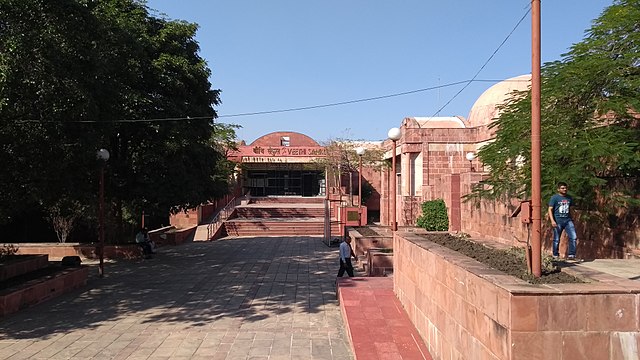
The Indoor Museum (Veethi Sankul)
The Indoor Museum of IGRMS is housed within a dome-shaped architecture- Veethi Sankul- and now boasts 12 galleries portraying various aspects of human culture. The entrance gallery ‘Bio-cultural Evolution of Man’ is meant to present you with information on ‘Man’ as a physical being and his evolutionary journey from prehistoric times. This gallery has been enhanced with information on ‘Human Variation.’
You can see that the rest of the galleries are classified as ‘Human Odyssey’ and demonstrate the rich and diverse cultural patterns of tribal and rural India.
The galleries are thematically designed, featuring models, graphics, dioramas, showcases, panels, and rare ethnographic artefacts collected from different parts of India and abroad. A visual Storage-cum-Research Gallery has also been developed to provide research inputs to students, scholars, and academicians.
The Indoor Museum has a reference library with a huge collection of books, research journals, and manuscripts in so many languages. Veethi Sankul also has an amphitheater with about 300 seating capacity for the presentation of performing arts. Veethi Sankul is again annexed with a 250-people capacity auditorium.
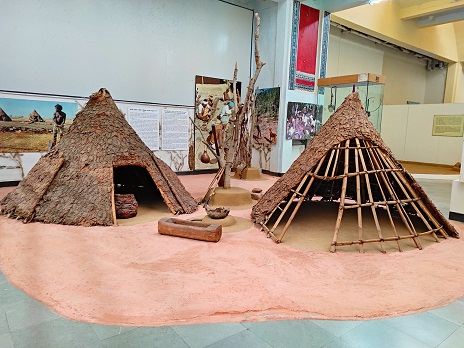
Reccomonded Read: Sanchi Stupa: All you need to know about this Buddhist treasure
The Galleries
As I have said earlier that the entrance to the indoor museum (Gallery-1) is about the evolution of man. Thus, when you step into the first gallery, you are greeted by a huge DNA double helix model which is the highlight of the gallery. This is a symbolic representation of humankind’s genetic unity and the fact that human variation, both morphological and cultural, is merely superficial to the species’ fundamental genetic oneness.
Gallery-2 enables you to understand that tribal and folk communities living in different ecological environments adopt distinct livelihood patterns based on socioeconomic mode of adaptation. The gallery showcases cultural objects on settlement patterns, subsistence and aesthetic activities of hunter-gatherers, shifting cultivators, pastoralists, peasants and ethno-medical practitioners in India.
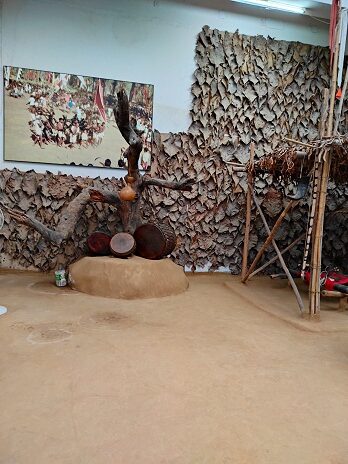
The exquisite collection in Gallery-3 is dedicated to one of the Gonds’ most important festivals, the Koitor Yatra or Lingo Yatra. These stories link the Gonds to the Koitor, who were formerly the Gond tribe of Bastar and have kept their traditional and indigenous ways of life.
While entering this beautiful exhibition, one may discover beautiful collections of pictures and material cultures that are nicely presented, creating a festive atmosphere. The Gonds’ life cycle has been depicted in an unusual way through their fairs and festivals, which are an important part of their tradition. This small but interesting gallery features a wide variety of interesting objects.
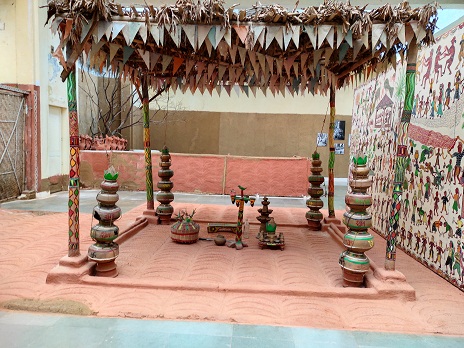
Now, you come to Gallery-4 which provides a comprehensive overview of the Bhils, a major tribe found in Madhya Pradesh, Gujarat, Rajasthan, and Maharashtra. Despite the fact that they have lost ground to new settlers and have not been exposed to technology, the Bhils of Gujarat are highly recognised for their skilled agricultural methods, fairs and festivals, wood carving and painting traditions. They have been able to preserve their culture and heritage over the years, as seen by the exhibitions.
This gallery contains some noteworthy exhibits on ritual features of the society, such as clay-relief work, paintings, and objects such as Gohri Puja, Bhil and Rathwa marriages (Mandava), Pabuji’s Shrine, Ind Puja, and so on.
The highlights of the gallery are the 40 black and white photographs captured in the mid-20th century A.D. by renowned photographer Late Anandi Lal Pareek depicting vivid details of various aspects of life, costumes, ornaments, and bodily features like tattoos.
Gallery No. 5 showcases ethnic art forms. It contains a variety of sculptures, exquisite wood carvings, colourful marriage lamps, clay and lattice works, Gond painting, and tattoo art created by tribal and folk artisans from across the country. One of the noteworthy exhibits is a giant-sized painting of an elephant by a Gond artist in his indigenous style. The centre of this gallery is dominated by an outstanding work of art represented by a huge panel of lattice work by Rajwar artisans. It is an important feature of this gallery.
Gallery-6 is appropriately titled ‘Belief Systems, Cosmology, and Rituals,’ as it displays ritual objects, photographs, masks, memorial pillars, paintings, and so on to narrate cosmology, belief systems and rituals of different communities. The exhibits include works on the highly ritualistic Himalayan Buddhism, Spiritual belief of Car-Nicobarees, Belief system associated with sacrificing pillars and Ahoi Ashtami.
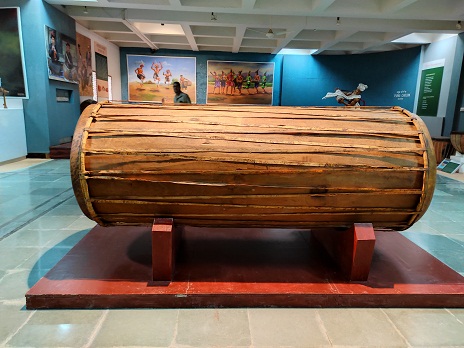
You may also like: A trip to the Udayagiri caves near Bhopal
Gallery-7 takes you on a journey through the cultural legacies of India’s tribal, folk, and classical musical traditions. The displays are arranged in a typological order and include: types of instruments with explanatory labels (bi-lingual), the I.G.R.M.S’s first three musical collections, 3D models and paintings by artists from North-east India, a collection of massive drums, Baul Sangeet of West Bengal, a Periodical Exhibition Corner, and an Interactive Stage for visitors.
Gallery-8 is dedicated to different types of masks from across the country. Mask is claimed to be one of India’s oldest material culture and the gallery features a huge collection of masks prominent among which are the Metal masks, Buddhist masks and the Chhau masks of West Bengal.
Gallery-9 delves into South India’s aromatic culinary culture with exquisite displays of kitchen traditions of the Chettiyar community and Nambudri Brahmins of Tamil Nadu and Kerala. These kitchens display a diverse range of traditional kitchen wares, from metal utensils to huge wooden containers, ladles, pots, and stone wares.
Other areas in this gallery feature artistic expressions of a wide range of human activities, such as wood carving, bead work, and traditional needlework pieces from different parts of India. This gallery’s major attractions include ornately carved wooden pillars and large wooden dowry boxes.
Gallery-10 is unlike the thematic galleries that you have already visited. You are treated to a visual delight of a plethora of artifacts that not only give a taste of the immense diversity of India but also give a sense of human diversity and scope of human creativity and Imagination.
This Gallery houses more than 4000 objects which are arranged according to their functional categories. These collections may serve to widen the scope of knowledge and contribute towards ethnographic research of the researchers, academicians and students.
You can find Gallery-11 quite interesting as the exhibits here showcase the social and cultural diversity of North-East India. The gallery is dedicated to the seven hill states of North-East India. The gallery is dominated by Naga culture (of Nagaland) which features some major Naga tribal collections that chronicle the glorious tradition of fertility cult and the yearning for social achievement.
Apart from the Naga Memoirs, the gallery also houses the Sikkim and Sikkimese, Jhankriwala, the healing practices of Shamams in Sikkim and the Clan Representing Swords of Manipur sections.
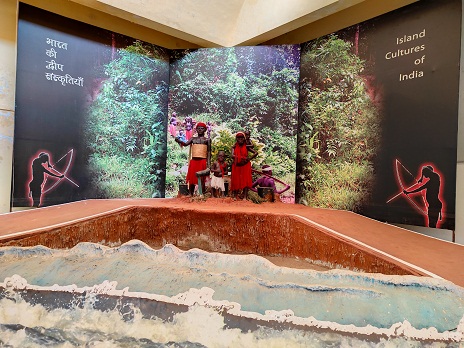
With Gallery-12, you come to the end of the Indoor Museum. The gallery is about the Island Culture of India that boasts some 18 rare objects acquired from the Zonal Anthropological Museum of the Anthropological Survey of India, Port Blair. The gallery also include exhibits that helps you to explore the cultural life of the islanders of Andaman and Nicobar, Lakshadweep, the Krishna, Godavari and Kaveri river islands in South India, the Brahmaputra river island of Assam, and the coastal lagoon of Odisha.
The gallery displays are visitor-friendly and interactive, culminating a great Museum visit.
More on MP travel: 12 Amazing Bhopal tourist places that you must not miss (2022)
The Outdoor Museum (Open-air Exhibitions)
When you are done with visiting the indoor museum (Veethi Sankul) and come out of the museum building little you know that there is more in store for you. Apart from the indoor galleries, IGRMS also boasts an outdoor museum with open air exhibitions. The outdoor museum has 10 open air exhibitions that include the Kumbhar Para, Traditional Technology Park, Himalayan Villages, Coastal Villages, Desert Villages, Prehistoric Rock Arts and so on.So, let’s take a walk of the outdoor exhibits.

Kumhar Para (Potters Village)
When you come out of the museum building, the first open air exhibition you come across is Kumhar Para. This open air exhibition is entirely the result of pottery and terracotta workshops organised by IGRMS during the past 10 years. Potters from different parts of India were invited to IGRMS in phases to demonstrate their skills and make traditional pottery and terracotta, which are now on display as part of an open-air exhibition called “Kumhar Para” (potters village).
The exhibition aims to provide a brief ethnographic account of different pottery traditions in India, particularly Assam, Gujarat, Ladakh, Jammu & Kashmir, Manipur, Odisha, Tamil Nadu, and West Bengal.

Traditional Technology Park
After visiting Kumhar Para, you next visit the Traditional Technology Park that is an exhibition of objects related to traditional technology from across the country. This exhibition tells you about the intelligence and creative genius of simple societies. This is also meant to broaden the perspective of the visitor by emphasizing the fact that traditional technologies contribute an important background to the technological splendor of the modern world. The displays in the exhibition includes Dokra Craft of West Bengal and Odisha, Bhati of Bihar, Ganna Charkhi of Chhatisgarh, Gharat of Uttarakhand and Dhenki of Chhatisgarh.
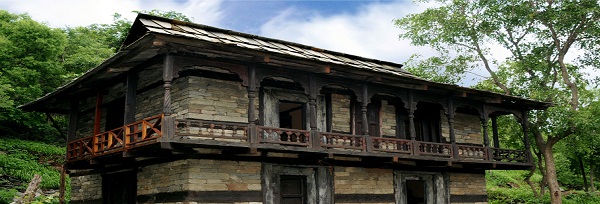
Must Read Post: Dancing Shiva of Chidambaram: Where science meets spirituality
Himalayan Village
Another highlight of the outdoor museum is the Himalayan village. The typical stone building of Kothi- the housing complexes of Shimla, Himachal Pradesh- is one of the interesting and intriguing items in the outdoor museum. The Chokhat, a towering four-storied home with a stone slate roof, is another remarkable house type from Uttrakhand.. The magnificent entrance gate known as Parol or Paraud was built to safeguard and beautify this open air exposition. The process of expanding this exhibition area is being continued with the addition of many more house types from the Himalayan region.
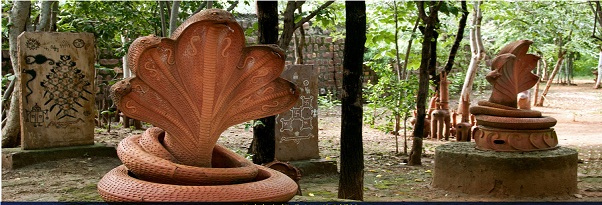
Mythological Trail
Myths and stories from diverse communities have been presented in different media in this exhibition (terra- cotta, wood, stone, iron, etc.). The major feature of the exhibition is the crafts of various artisan groups, incarnations of folk deities, and traditional paintings. A 12 ft. tall iron
gate with decorative carvings, rep- resenting the origin and technology of ironsmithy (done by the Lohars of Bastar), forms an imposing structure of this exhibition.
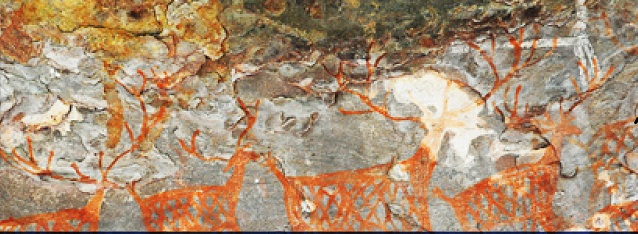
Rock Art Heritage
When I visited the Bhimbetka Rock Shelters the other day, little did I know that Indira Gandhi Rashtriya Manav Sangrahalaya is one of the few museums in the world where prehistoric rock paintings may be found. Using some of these shelters, the museum has developed an open air exhibition called Rock Art Heritage. There are 36 rock shelters with prehistoric paintings spread over 4 locations on the museum premises. This exhibition opened in the museum in 1991.
The museum has built a separate structure beside the chain of rock shelters. This structure, known as the ‘Adi’ or ‘Rock Art Center,’ was built to provide an introductory orientation to rock art in India, with a focus on the rock art at Indira Gandhi Rashtriya Manav Sangrahalaya’s shelters.
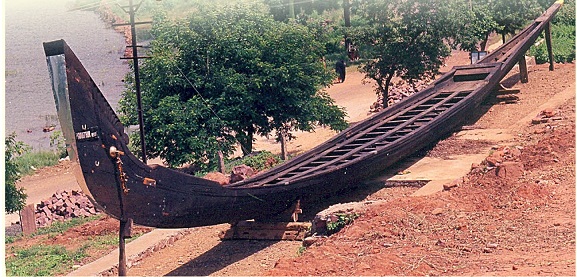
Coastal Village
This exhibition is set on about 20 acres of land and depicts dwelling units and related material cultural artefacts from several coastal districts of India, including Gujarat, Kerala, Tamil Nadu, Andhra Pradesh, and Orissa. These are typical traditional house types that depict Indian coastal populations’ lives and cultural identities. Some of the eco-friendly structures featured in this complex reflect the socio economic status of the locals, such as the ‘Arapura’ (wooden house) and ‘Palliyodam’ (snake-boat) from Kerala.
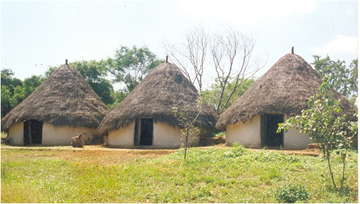
Desert Village
This exhibition is dominated by typical Rajasthani and Gujarati dwelling types from Jaisalmer and Kutch desert regions. The major exhibits in this exhibition are a Rajput desert dwelling complex and a traditional Bhunga of the nomadic Rabari people of Kutch, which highlight the process and degree of their adaptation to the environment.
Various ethnographic artefacts displayed inside the dwellings illustrate the living populations’ ways of life and subsistence strategies. This exhibition features a traditional stone structure from Jaisalmer and a huge Chhattri, both of which are important examples of Rajasthan desert stone architecture.
River valley cultures
This exhibition is about the Gond, Pardhan, and Baiga tribes who live along the Narmada River near its source recount numerous folk tales that reflect the cultural personality of the river, which appears to be in the minds of the people from time immemorial.
A few of the villagers’ stories were taped in an artist’s camp some time ago. The stories presented here were somewhat more popular and served as the foundation for the art works done by adivasi people who adopted one or more parts of the stories as their concepts.
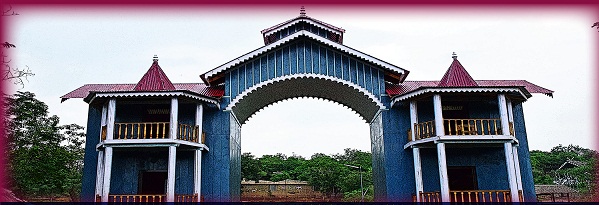
Tribal Habitat
The Tribal Habitat Open Air Exhibition is one of IGRMS’s most important exhibitions. It is represented by collections of life-size traditional house types from India’s indigenous tribal and folk communities. This exhibition highlights the aesthetic beauty, extraordinary craftsmanship, knowledge, and wisdom of the exquisite forms of tribal architecture that conforms to their sustainable way of livelihood.
It presently features 40 exhibits, including life-size dwelling complexes, shrines and temples, youth dormitories, village gates, and hamlets. The Introductory Gallery at the exhibition’s base provides immediate information on the culture of the tribes portrayed in this exhibition.
Sacred Groves
This exhibition features replicas of sacred groves of Kerala, Chhattisgarh, Meghalaya, Manipur, Maharashtra, Tamil Nadu, West Bengal, and Rajasthan. Plants from these states’ groves were planted in their respective replicas, with the geo-climatic conditions of Bhopal in mind.These groves have been ritually established through rites performed by local communities.
Travel Tips
How to reach
IGRMS is located at Lake View Road, Shymala Hills in Bhopal. The museum can be reached either from the Upper lake side or from Shymala Hills side. You can take a taxi to reach the museum. It is about 10 kilometers from the main bus terminal in the city and 7 kilometers from Bhopal railway Junction
Entry fee.
Free Entry : Children upto 12 years.
Entry tickets, Rs. 50/- per head and Rs. 25/- concessional charges for students and groups. Entry of the children age below 12 years is free for visitors students on production of Identity cards. All the tickets available on gate no. 1 (near to Regional College entry gate) and gate no. 2 (toward boat club at Van Vihar Road).
Museum Timings
Visiting hours : March to August 11.00 hrs. to 18.30 hrs. and September to February 10.00 hrs. to 17.30 hrs.
Opens on : Every day except Mondays and National Holidays.
Reference Library
The Library of IGRMS is located in a specially designed enclosure of the Veethi-Sankul (Indoor Museum building). It is being developed as a Research and Reference Library to cater the special research needs of scholars engaged in academic pursuits in different areas of social science research. The Library has a rich collection of about 40,000 books and it is open for the general readers, visitors and Museum professionals. For more information visit – www.igrms.gov.in/ library.html.
Southern Regional Centre (Mysore)
IGRMS also has a regional centre situated in South India at Mysore, Karnataka functioning from a historical building Wellington House.
Address: Southern Regional Centre, Wellington House, Irwin Road, Mysore – 571001; (Karnataka), India

